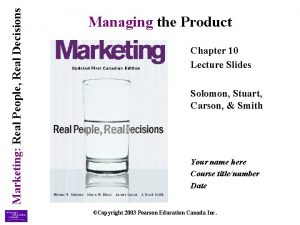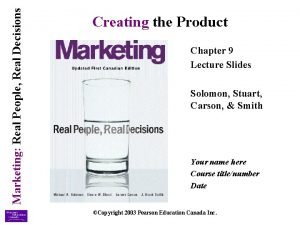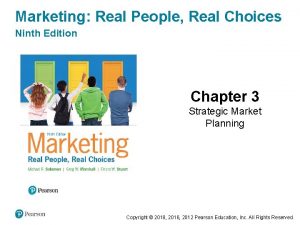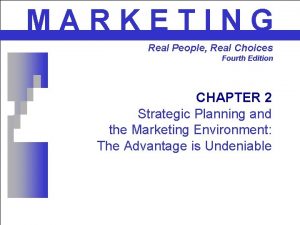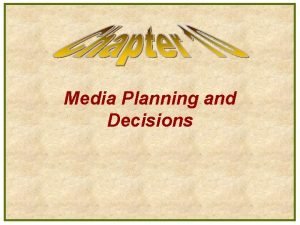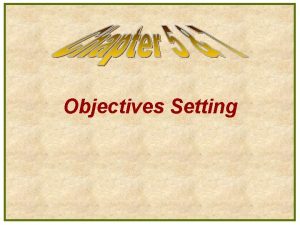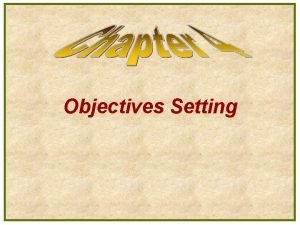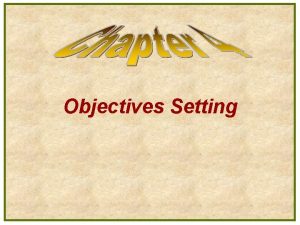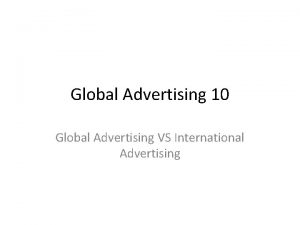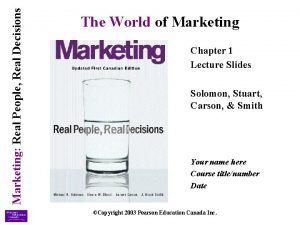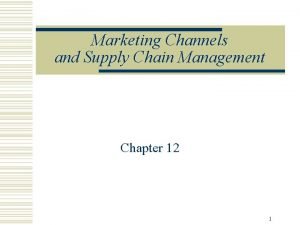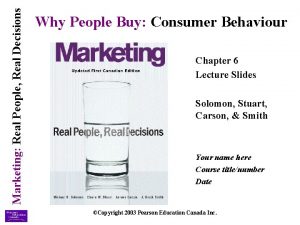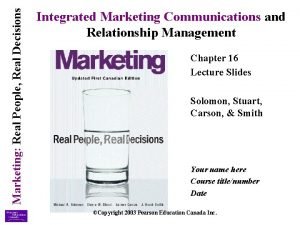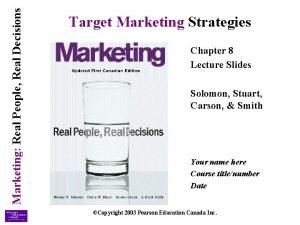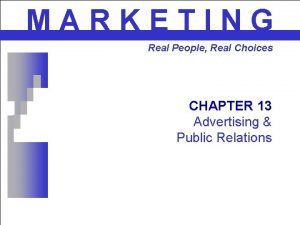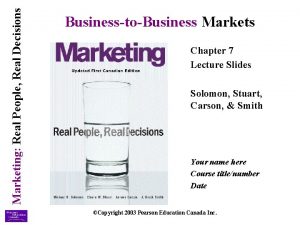Marketing Real People Real Decisions Advertising Chapter 17
















- Slides: 16

Marketing: Real People, Real Decisions Advertising Chapter 17 Lecture Slides Solomon, Stuart, Carson, & Smith Your name here Course title/number Date ©Copyright 2003 Pearson Education Canada Inc.

Marketing: Real People, Real Decisions Chapter Learning Objectives When you have completed your study of this chapter, you should be able to: • Tell what advertising is and describe the major types of advertising. • Describe the major players in the advertising process. • Tell how advertisers develop an advertising campaign. • Discuss the challenges facing advertising. • Explain how advertisers evaluate the effectiveness of the campaign. • Describe the major advertising media and the important considerations in media planning. ©Copyright 2003 Pearson Education Canada Inc. 2

Marketing: Real People, Real Decisions Introduction to the Topic • This is the second of three chapters on promotion, the previous chapter dealing with the strategy side of an integrated marketing communications program, while this chapter focuses solely on advertising. • To refresh our memory, advertising is one component of an IMC, which is part of promotion in the marketing mix. • The purpose of promotion is to communicate what the organization has to offer to its intended target market(s) and other interested stakeholders. • Advertising just happens to be the most fun part of the program. ©Copyright 2003 Pearson Education Canada Inc. 3

Marketing: Real People, Real Decisions The Nature of Advertising • Advertising: non-personal communication paid for by and identified sponsor using mass media to persuade or inform. • Advertising can come in many different forms and for different purposes. • Product advertising: an advertising message that focuses on a specific good or service. The majority of advertising is done to promote specific products. • Institutional advertising: an advertising message that promotes the activities, personality, or point of view of an organization or company. • Such as this advertisement for Pfizer. ©Copyright 2003 Pearson Education Canada Inc. 4

Marketing: Real People, Real Decisions The Nature of Advertising (continued) • Advocacy advertising: a type of public service advertising provided by an organization that is seeking to influence public opinion on an issue because it has some stake in the outcome. • Lobby groups such as the NRA would do this type of advertising. • Public service advertisements: advertising run by the media without charge for not-for-profit organizations or to champion a particular cause. • Such as this one for a camp for children with AIDS. • Advertising agencies will often support these organizations by working on such advertising on a pro bono basis. ©Copyright 2003 Pearson Education Canada Inc. 5

Marketing: Real People, Real Decisions Who Does Advertising? • An advertising agency is a service firm that specializes in creating advertising for client companies. Agencies will vary in the amount and variety of services offered, such as: – Account management – Creative services – Marketing research – Media planning • The value created by an agency is in translating the communications objectives of the client into activities that accomplish those objectives. • Today’s full-service agencies prefer to call themselves communications services companies to reflect the variety of services offered. ©Copyright 2003 Pearson Education Canada Inc. 6

Marketing: Real People, Real Decisions Developing an Advertising Campaign • Advertising campaign: a coordinated, comprehensive plan that carries out promotion objectives and results in a series of advertisements placed in media over a period of time. • Creative strategy: the process that turns a concept into an advertisement. • Advertising appeal: the central idea or theme of an advertising message. • This is the most difficult part of creating advertising, which is coming up with ideas as to how to express a message. • For example, what the heck is this? ©Copyright 2003 Pearson Education Canada Inc. 7

Marketing: Real People, Real Decisions Types of Advertising Appeals • Unique selling proposition (USP): an advertising appeal that focuses on one clear reason why a particular product is superior to any others. • • Comparative advertising between competing products. Demonstration showing the product being used. Testimonial using a credible source to tell of its benefits. Slice-of-life showing how the products fits everyday life. Lifestyle showing the expressive or symbolic qualities of the product. Fear appeals to scare the viewer into changing their attitude. Sex appeals to attract attention and promote a product. Humorous appeals to break through the clutter and get noticed. ©Copyright 2003 Pearson Education Canada Inc. 8

Marketing: Real People, Real Decisions Developing an Advertising Campaign • Pretesting: a research method that seeks to minimize mistakes by getting consumer reactions to advertising messages before they appear in the media. • Copy testing: a marketing research method that seeks to measure the effectiveness of advertisements by determining whether consumers are receiving, comprehending, and responding to the advertisement accordingly. • Copy testing can be used for: – concept testing – test commercials – finished testing ©Copyright 2003 Pearson Education Canada Inc. 9

Marketing: Real People, Real Decisions Choosing a Media • Media planning: the process of developing media objectives, strategies, and tactics for use in an advertising campaign. The goal is to reach the target audience in the most effective manner. • Aperture: the best place and time to reach a person in the target market group. This requires an in-depth knowledge of the segmentation strategy being used and the characteristics of the target market(s). • Computer media: communications media that transmit information through the Internet or via e-mail messages. • Out-of-home media: communications media that reach people in public places. ©Copyright 2003 Pearson Education Canada Inc. 10

Marketing: Real People, Real Decisions Pros and Cons of Selected Media ©Copyright 2003 Pearson Education Canada Inc. 11

Marketing: Real People, Real Decisions Media Scheduling • Media schedule: the plan that specifies the exact media to use and when. • Advertising exposure: the degree to which the target market will see an advertising message placed in a specific vehicle. • Impressions: the number of people who will be exposed to a message placed in one or more media vehicles. • Reach: the percentage of the target market that will be exposed to the media vehicle. Figure 17. 1 ©Copyright 2003 Pearson Education Canada Inc. 12

Marketing: Real People, Real Decisions Media Scheduling (continued) • Frequency: the number of times a person in the target group will be exposed to the message. • Gross Rating Points (GRP’s): a measure used for comparing the effectiveness of different media vehicles: average reach times frequency. • Cost per thousand (CPM): a measure used to compare the relative cost effectiveness of different media vehicles that have different exposure rates: the cost to deliver a message to 1, 000 people or homes. ©Copyright 2003 Pearson Education Canada Inc. Figure 17. 1 13

Marketing: Real People, Real Decisions Evaluating Advertising • Post-testing: research conducted on consumers’ responses to actual advertising messages they have seen or heard. • Unaided recall: a research technique conducted by telephone survey or personal interview that asks how much of an advertisement a person remembers during a specified period of time. • Aided recall: a research technique that uses clues to prompt answers from people about advertisements they might have seen. • Attitudinal measures: a research technique that probes a consumer’s beliefs or feelings about a product before and after being exposed to messages about it. ©Copyright 2003 Pearson Education Canada Inc. 14

Marketing: Real People, Real Decisions Challenges Facing Advertising • The advertising industry faces a number of challenges in today’s marketing environment: • Erosion of brand loyalty due to emphasis on price. • Effect of technology putting more power in the hands of the consumer. • Greater emphasis on point of purchase factors when making purchase decisions. • Competition from non-traditional sources using special effects and technology. • Cluttered advertising environment makes it difficult to get noticed. • Cynical consumers are turned off by advertising and are tuning out. ©Copyright 2003 Pearson Education Canada Inc. 15

Marketing: Real People, Real Decisions Famous Last Words… • Advertising is a big part of our daily lives, whether we choose to notice it or not. • Advertising has tremendous power to communicate to the masses, if we could just figure out who those masses are! ©Copyright 2003 Pearson Education Canada Inc. 16
 Marketing real people real decisions
Marketing real people real decisions Marketing real people real decisions
Marketing real people real decisions Meaning of poster making
Meaning of poster making Ch 9 ream people real choice case study
Ch 9 ream people real choice case study Marketing real people real choices
Marketing real people real choices Slidetodoc.com
Slidetodoc.com Screening decisions and preference decisions
Screening decisions and preference decisions Gross rating points
Gross rating points Major decisions in advertising
Major decisions in advertising Major decisions in advertising
Major decisions in advertising Major decisions in advertising
Major decisions in advertising Global advertising and international advertising
Global advertising and international advertising Marketing real people
Marketing real people People with political savvy make decisions that:
People with political savvy make decisions that: What is channel level
What is channel level Retail marketing decisions
Retail marketing decisions What is channel design?
What is channel design?
